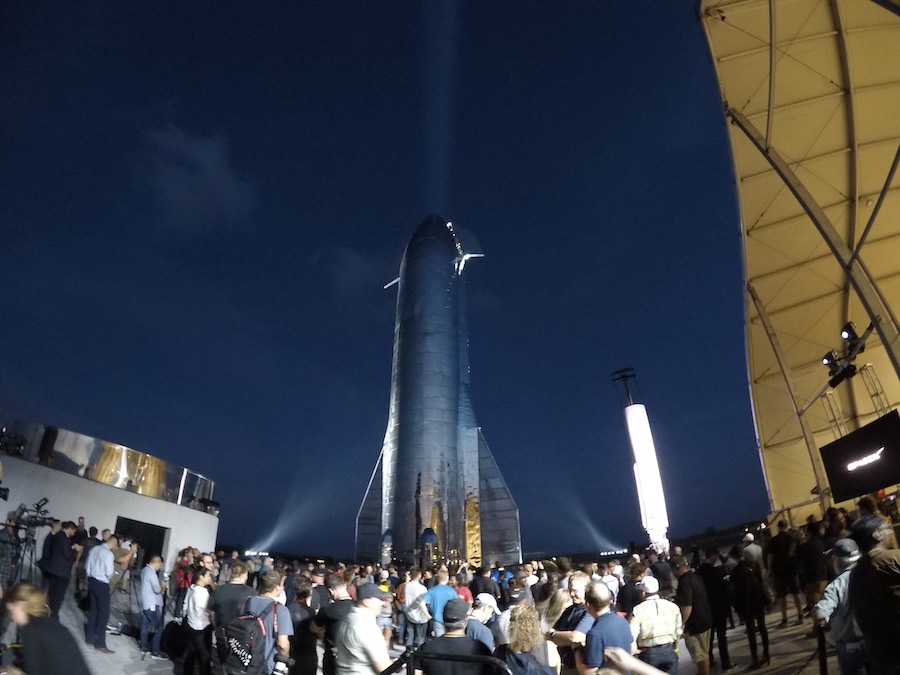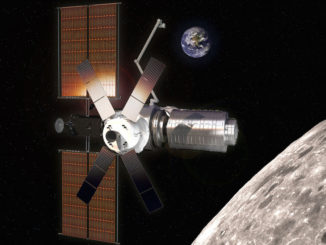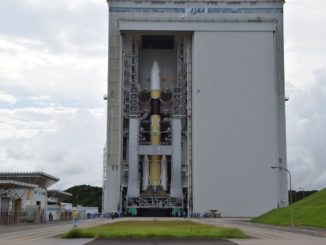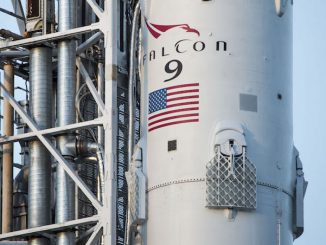Video credit: @LabPadre / LabPadre on YouTube
SpaceX’s first partially-assembled Starship vehicle, originally built for atmospheric test flights, ruptured in dramatic fashion Wednesday during a cryogenic loading test at the company’s launch facility in South Texas.
The winged rocket appeared to blow its upper bulkhead while undergoing testing at SpaceX’s Boca Facility facility on the South Texas coast around 4:30 p.m. EST (3:30 p.m. CST; 2130 GMT) Wednesday.
A cloud of cryogenic fluid, possibly oxygen or nitrogen, erupted from the top of the vehicle, and video captured by nearby spectators appeared to show the upper tank bulkhead launching hundreds of feet into the air before falling to the ground near the Starship test stand.
The Starship vehicle remained largely intact after the accident, but some buckling was visible in its stainless steel skin.
“The purpose of today’s test was to pressurize systems to the max, so the outcome was not completely unexpected,” SpaceX said in a statement. “There were no injuries, nor is this a serious setback.”
But plans to fly the first full-size Starship vehicle, designed Mk1, on a test launch to an altitude of 65,000 feet (20 kilometers) have been shelved in favor of flying a future Starship rocket designed for orbital missions. In a press event at Boca Chica in September to update SpaceX’s Starship plans, Musk said the Starship Mk1 rocket — towering behind him on a Saturday night — would perform the atmospheric test flight.
The Starship is one of two components of SpaceX’s next-generation reusable launch system, which the company says will be the most powerful rocket ever built. Future Starship vehicles will be joined with a Super Heavy booster, which SpaceX is also developing, to loft massive payloads into Earth orbit, to the moon, Mars and other deep space destinations.
In a tweet after Wednesday’s Starship mishap, SpaceX founder and chief executive Elon Musk said SpaceX is moving on to an modified version of the Starship, the first of which is known as the Starship Mk3.
“This had some value as a manufacturing pathfinder, but flight design is quite different,” Musk tweeted, referring to Mk1.
“The decision had already been made to not fly this test article and the team is focused on the Mk3 builds, which are designed for orbit,” SpaceX said in a statement.
A separate SpaceX team in Cocoa, Florida, is building the Starship Mk2 test vehicle. SpaceX is constructing a launch mount for the Starship at launch pad 39A at NASA’s Kennedy Space Center, hundreds of feet away from the location where the company launches Falcon 9 and Falcon Heavy rockets.
Wednesday’s statement from SpaceX raised questions about the company’s plans for the Starship Mk2, which was previously intended to travel via road and barge from Cocoa to pad 39A for ground checkouts and potential flight tests.
Since completing the initial build-up of the Starship Mk1 vehicle in September, SpaceX outfitted the rocket with internal structures and other hardware necessary to fill the vehicle with super-cold methane and liquid oxygen propellants. The methane and liquid oxygen will feed Starship’s Raptor engines.
Six Raptor engines will power the orbital-class version of the Starship. In September, Musk said three Raptors will fly on the Starship for low-altitude tests, and up to 37 Raptor engines will power the Super Heavy booster.

The privately-developed Starship vehicle stands around 164 feet (50 meters) tall with its nose cone installed. The nose cone, which includes aerodynamic fins, was not on the rocket for Wednesday’s test. The vehicle measures around 30 feet (9 meters) in diameter, about one-and-a-half times the diameter of a Boeing 747 jumbo jet.
Combined with the Super Heavy first stage, the entire stack will stand around 387 feet (118 meters) tall.
The fully reusable Super Heavy/Starship launch vehicle will be able to loft some 150 tons of payload to low Earth orbit, according to Musk. The Starship serves as the upper stage of the combined vehicle, and SpaceX says it will introduce an in-space refueling capability to allow Starships to ferry heavy payloads into deep space.
Both stages will be reusable, returning to Earth for vertical propulsive landings similar to SpaceX’s Falcon rocket boosters. SpaceX only recovers the first stage on its Falcon rocket family.
The Starship will eventually replace the Falcon family of rockets, hauling satellites into orbit and delivering cargo and crews to the moon and Mars, according to SpaceX.
On Monday, NASA announced SpaceX is one of five companies joining the agency’s commercial lunar lander program. SpaceX’s Starship is one of NASA’s options to deliver experiments and cargo to the moon’s surface ahead of a planned human lunar expedition in 2024.
Gwynne Shotwell, SpaceX’s president and chief operating officer, said Monday that the company aims to land a Starship on the moon in 2022 without humans on-board. A crewed Starship flight will come some time later, Shotwell said.
Email the author.
Follow Stephen Clark on Twitter: @StephenClark1.



